"Oppenheimer" Reviews |
Read more at in70mm.com The 70mm Newsletter |
| Written by: Francesco Gualeni (Italy), Howard B. Haas, (USA), Mark Lyndon (UK), Jonathan Kleefield, M.D. (USA), Paul Margulies (UK), Scott Pickering (Canada) & Mark Trompeteler, FBKS (UK) | Date:
24.07.2023 Updated: 22-01-2025 |
"Oppenheimer" - A Cinematic Paradox - in 15/70mm
and 5/70mm.
|
|
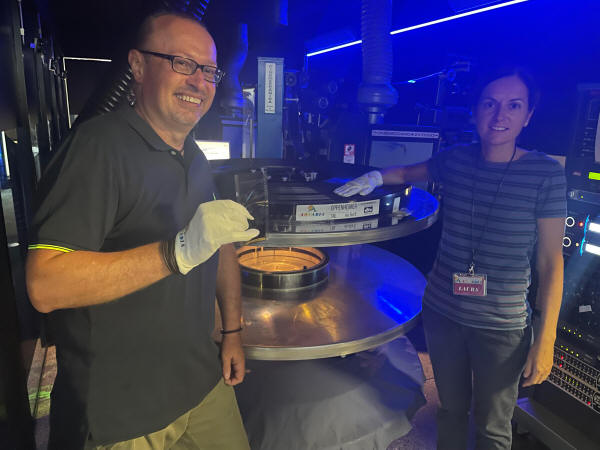 Francesco
Gualeni and Laura Fumagalli, Arcadia Francesco
Gualeni and Laura Fumagalli, ArcadiaThis summer I was blessed to be able to see Nolan's latest masterpiece, "Oppenheimer", in the two best ways that a movie can be seen today: IMAX 15/70mm and 5/70mm. I saw "Oppenheimer" in 15/70mm at BFI London twice, in the first showing on the 5th of August I watch the movie, the second time on the 9th of August, I focused more on the technical aspects. Due to the pandemic, I had missed the IMAX screening of "Tenet" in 2020 so the last film I had seen in 15/70mm was "Dunkirk", in 2017. For this reason, I was very excited to be able to see the film in this beautiful format and expectations were met (partially...). "Oppenheimer" is a beautiful movie, with a magnificent Cillian Murphy and an even greater Robert Downey Jr. It is a movie with an uncommon lengthtime (three hours) but this allows you to enter even more in tune with the story both from an emotional and a psychological point of view, also because the film is unfortunately of a disconcerting relevance these days, even if it tells a story set in the 1940s. The IMAX scenes shot in black and white with the new 65mm film stock Kodak has provided especially for this movie are thrilling and the quality of the film offers blacks and contrasts that no digital projection can match. However, I was a bit disappointed with the logic behind the ratio’s change from 1.43 IMAX to 2.2. Unlike what had happened before for "The Dark Knight Rises", "Interstellar" or "Dunkirk" where entire sequences were shot in IMAX and presented in 1.43, in "Oppenheimer" the change of format from 1.43 to 2.2 also takes place discontinuously within the same sequence. I can understand that this is due to the difficulty of using the noisy IMAX camera in certain scenes where the dialogue is recorded live, but the change in between formats really creates a certain visual distraction. Nevertheless, for those who love movies on the big screen, watching "Oppenheimer" in 15/70mm is a real joy for the eyes and when the images open up in all their size, definition and brightness, I only wished those images would never end. |
More in 70mm reading: in70mm.com News About "Oppenheimer" and Large Format Where to see "Oppenheimer" in the Splendour of Glorious 7OMM "Oppenheimer" Production Notes "Oppenheimer" is Christopher Nolan's next adventure in IMAX 7OMM "Tenet" | "Dunkirk" | “Interstellar” | "Inception" "Nope" Panavison Large Format Motion Picture Systems in70mm.com's IMAX Page |
 "Oppenheimer"
at the BFI IMAX in London, UK. Photo by Francesco Gualeni "Oppenheimer"
at the BFI IMAX in London, UK. Photo by Francesco GualeniAt the end of the screening, I asked if I could visit the projection booth and the BFI staff was very kind to accompany me and show me the famous 11 mile long reel, which many have already written about, to give me a piece of IMAX film and to tell me a little of technical curiosities as an example that the 4K laser projector at the BFI is currently not set up to project films in 1.43 but only in 1.90 and this is a real shame because at the Science Museum I saw the IMAX documentary “Under the sea” in laser 4K 3D in 1.43 and it was truly spectacular. I think many underestimate the 1.43 ratio which is one of the fundamental parts of the IMAX experience, an experience that is completely lost in digital IMAX 1.9 projections. Back to Italy, I had to wait until August the 23rd, the day the film was released in my country. Only three 70mm prints were distributed. One of these is at the ARCADIA Cinema in Melzo - Milan, a 70mm cathedral whose mission, since opening, has always been to present movies in the best way as possible. Unfortunately, I missed the events on the premiere day. At the end of the very first morning screening starting at 10.30 am, ARCADIA has hosted a special “Post Screening reactions” with astrophysicist Luca Perri. He has brieftly introduced the audience to concepts like scientific’s fission and fusion, to how “the Gadget” has been built and successfully detonated and all details of the Mahnattan project. |
|
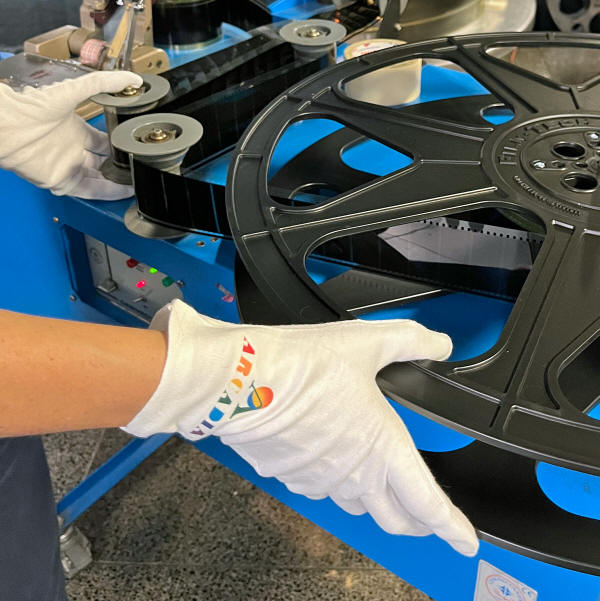 White
gloves to handle 70mm is mandatory at the
Arcadia cinema, Melzo, Milan. Photo by Arcadia White
gloves to handle 70mm is mandatory at the
Arcadia cinema, Melzo, Milan. Photo by ArcadiaIn preparation of "Oppenheimer"’s release, since November 2022, ARCADIA has held a series of conferences “Science & Nolan Films”. They had started with “The Science of 2001 A Space Odyssey” (one of Nolan’s favourite film) and had continued throughout 2023 with “The Science of Interstellar” in January, “The Science of Tenet” in March, “The Science of Inception” in May. The full conference “The Science of Oppenheimer” will be held on September 23rd and it is already sold out. As in the previous conferences, astrophysicist Luca Perri will lure the audience in highly interesting conference on everything science-related to "Oppenheimer". I saw "Oppenheimer" in ENERGIA PLF Screen on August the 25th. At the entrance, the staff handed out a special give-away, a 70mm film frames strip. Laura Fumagalli told me patrons are driving hundreds of kms from all over Italy to see "Oppenheimer" in 70mm in ENERGIA. The vast majority of showtimes are in Italian Dubbed but they have received an unprecedented demand for screenings in Original Version with subtitles. So I know they are adding more of those in the weeks ahead. |
|
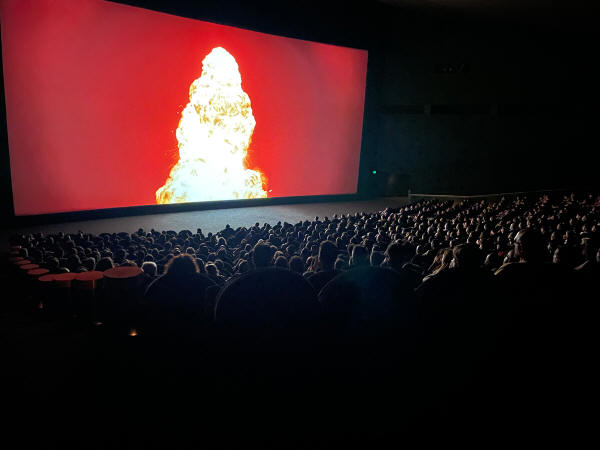 Screen
30 meter across. Sold out show of "Oppenheimer" at the ENERGIA PLF Screen at
Arcadia cinema, Melzo, Milan. Photo by Arcadia Screen
30 meter across. Sold out show of "Oppenheimer" at the ENERGIA PLF Screen at
Arcadia cinema, Melzo, Milan. Photo by ArcadiaThe 70mm print was perfect and the projection excellent, as always. The black and white images had unprecedented depth and contrast and the huge 30 meters wide screen made even more spectacular. The amazing Meyer Sound speakers have fully immersed me in the movie and brought out all their power in the shockwave and post-explosion scenes. Wow ! I always thank everyone, all over the world, who make efforts to preserve the cinema experience on 70mm film, and especially to ARCADIA for their ongoing offerings of 70mm high quality projections to Italian moviegoers (in Italy there are no 15/70mm IMAX theaters anymore). It is difficult to make a comparison between 15/70mm and 5/70mm presentations. They have different auditoriums, different aspect ratios in some sequences, different screen sizes, different sound systems but both are a wonderful way to be part of the cinematic experience, different but the same, at the same time. A cinematic paradox. Francesco Gualeni 04.09.2023 |
|
"Oppenheimer" in 15/70 IMAX – The change is amazing in its effect
|
|
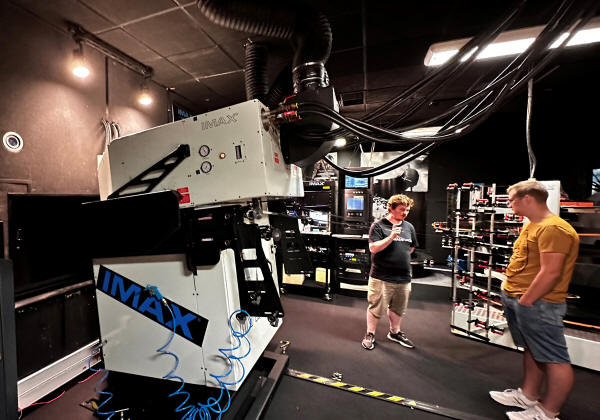 The
Imax 70mm projector which has been lovingly maintained, and with the
exception of "Tenet", has shown Nolan’s film going back to the Dark Knight
series in 15/70. The
Imax 70mm projector which has been lovingly maintained, and with the
exception of "Tenet", has shown Nolan’s film going back to the Dark Knight
series in 15/70. To me it seemed that the film was 1.43:1 for more than 50% of the running time. There are places where it switches suddenly within a single shot. The change is amazing in its effect. It is just jarring enough to focus attention on the subject matter. I think it actually adds to the overall dramatic impact of the scene. I haven’t seen the film in another format, so I can’t compare. Having now caught 3 screenings of "Oppenheimer" in 15 perf/70mm at the Imax theater in Cinema City – Flora, in Prague, I can say that the 3rd time was as pristine as that first public screening (after more than 100 runs). I caught the first “preview” screening on July 20th, 2023 (at 12.01am), another 2 weeks later and finally a late screening on August 22nd. Interestingly, Cinema City has managed to eke out more screenings past the end-by date. While under contract for "Blue Beetle", "Gran Turismo" and now "Equalizer 3", the theater is showing Oppenheimer once an evening. It’s possible due to the relatively short running time of the Denzel Washington film. So far, the schedule shows the 70mm print screening once-per-night until September 6. While not yet sold-out, the only remaining seats are in the front two rows. Amazingly, there have been 2nd shows on weekends, beginning at 12:45am! Sold-out with an exit time of around 4am Cinema City management told me that, as the only Imax room in continental Europe, people from at least 15 countries, as far away as Finland have purchased tickets online. The Cinema City Flora complex is on the upper level of a shopping center in Prague, accessible via bus, tram and metro systems. The Imax theater seats 380 people in the very steep stadium layout, guaranteeing perfect viewing. The CinemaCity IMAX at the Flora shopping center is the only IMAX in the Czech Republic, and is the only theater in the EU showing this film in 70mm. The film has shown an average of 2-3 shows per day for 5 weeks. I saw the very first screening at the midnight premiere (12.01am - Thursday night), July 20. The print was clean, scratchless and showed no visible wear and tear after more than 100 runs through the projector. Kudos to the projection crew! Paul Margulies 25.08.2023 |
|
It was fantastic seeing "Oppenheimer"
in IMAX 70MM!
|
|
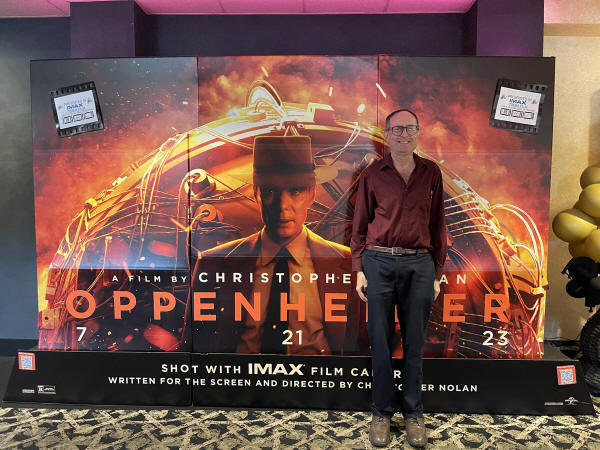 Howard B. Haas
at the King of Prussia IMAX Howard B. Haas
at the King of Prussia IMAXAs a Philadelphia resident, I was thrilled to see "Oppenheimer" at the only theater in the Philadelphia region to show it in IMAX 70MM, Regal's United Artists King of Prussia 16. First, this is a multiplex, but partly due to the IMAX, it is the most prominent mainstream movie theater in Philadelphia's western burbs, on the famously affluent "Main Line." It is a short distance from one of the nation's largest, and most successful shopping malls, the King of Prussia Mall. The multiplex was opened by the United Artists Circuit in 2000, with large screens, stadium seating, and surround sound in all auditoriums. It replaced smaller movie theaters in the King of Prussia area, and eventually became one of the "go to" movie destinations for the entire western suburbs and beyond. Since its opening, one screen has become a RPX (Regal Premium Experience) and another has become a 4 D auditorium. I myself have seen many new movies in the various non-IMAX auditoriums. I've also seen Fathom Classics there, which though shown digital, are often films which were originally filmed in 65mm or were blowup or were shown anyway in 70mm, notably, in the order that I saw them, "Cleopatra" (1963), "The Ten Commandments" (1956), "Ben Hur" (1959), "Star Trek: The Voyage Home" (1986). • Go to gallery "Oppenheimer" in IMAX 7OMM at the King of Prussia IMAX, USA Before "Oppenheimer" I had only seen IMAX 70MM films in the only other theater in the Philadelphia region that has shown them, Philadelphia's Franklin Institute which is in "Center City" (downtown). The Tuttleman IMAX opened in 1990 with a tilted, domed screen over 70 feet wide and four and a half stories tall, with more than 50 speakers and mostly showed educational, science films, but also occasionally showed Hollywood blockbusters. I saw three films there, and as with "Oppenheimer" two of those movies were directed by Christopher Nolan, "The Dark Knight Rises" (2012) and "Dunkirk" (2017). The last film I saw there was "Star Wars 8: The Last Jedi" (2017). I would have liked to have seen Nolan's "Tenet" (2020) there, but during the Pandemic, the Tuttleman IMAX was not open, and all New York movie theaters including AMC Lincoln Square with its IMAX were ordered closed, so I saw "Tenet" in the Dolby auditorium of Philadelphia's AMC Fashion District 8, which is also in Center City. The Tuttleman IMAX has not reopened, and unfortunately, a recent comment to the press by a Franklin Institute staffer indicated the theater might not reopen. |
|
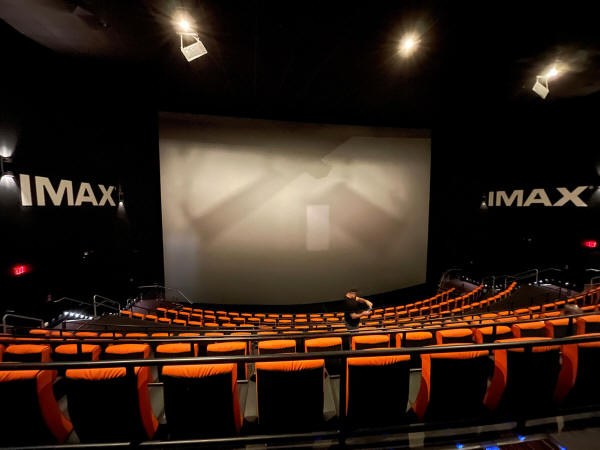 King
of Prussia IMAX cinema. Image: Howard B Haas King
of Prussia IMAX cinema. Image: Howard B HaasDays before "Oppenheimer" began, I went online to purchase a ticket, but I found that at the King of Prussia IMAX, all screenings for its first few weeks were sold out, or nearly sold out, leaving few seats. Some cities like the DC area and New York City had regular 70mm screenings of the movie, but the Philadelphia region had no 70mm screenings, and only one theater, the Philadelphia Film Center in Center City, showed the movie in 35mm. So though the region had other IMAX theaters showing "Oppenheimer" digitally, and has a few Dolby auditoriums that were showing it in Dolby Vision and Atmos, it was not surprising to find the King of Prussia IMAX 70MM has sold out every screening. When I arrived early for my 2 PM screening, on Tuesday, August 8, the IMAX auditorium, which is auditorium 9, but is clearly set off by its own entry hallways inside the multiplex, was packed for the earlier screening. Also waiting to enter was a man with his young son. The man eagerly told me he had driven 3 hours from the Maryland suburbs of Washington D.C., because there were no IMAX 70MM showings in his area. He had already seen "Oppenheimer" in digital, but his son had not seen the movie. It was fantastic seeing "Oppenheimer" in IMAX 70MM. The auditorium has about 250 seats, all comfortable recliner chairs, and I sat in the most rear row, which is my usual preference in most movie theaters. The sight line was excellent. The massive screen is 74 feet wide, 52 feet high, and is set to show the films in proper 1.43 IMAX aspect ratio. Though in its third week, the projected print quality seemed perfect. The resolution and visuals were excellent and needless to say to anybody reading my opinion in this newsletter, was far more beautiful than digitally filmed and digitally projected films. The sound was very good, though I have been spoiled by superior Dolby Atmos surround sound. Most, at least 80% of "Oppenheimer" filled the screen, meaning most of the film was filmed with IMAX cameras. The remainder was a bit letterboxed, at least at the top, so it was filmed with 65mm cameras, though that resolution seemed equally good to me. The movie itself was fantastic, far less convoluted and more "real world" to me than Nolan's "Tenet" I was a big fan of Nolan's "Dunkirk" but the gimmick of "Dunkirk" was WW2 being waged in three ways, on the ground, by sea, and in the air. "Oppenheimer" was more about plot. Everybody knows that the US succeeded in developing the atomic bomb, but I won't describe what later happened with the scientist Oppenheimer so I don't give movie spoilers. For me, especially seeing it in IMAX 70MM, the three hour "Oppenheimer" film was a riveting, compelling thriller, and was the best movie of the year so far! I would gladly return to the King of Prussia IMAX for any feature film in IMAX 70mm that I wish to see! Howard B. Haas 8. August 2023 |
|
IMAX Comes of Age!
|
|
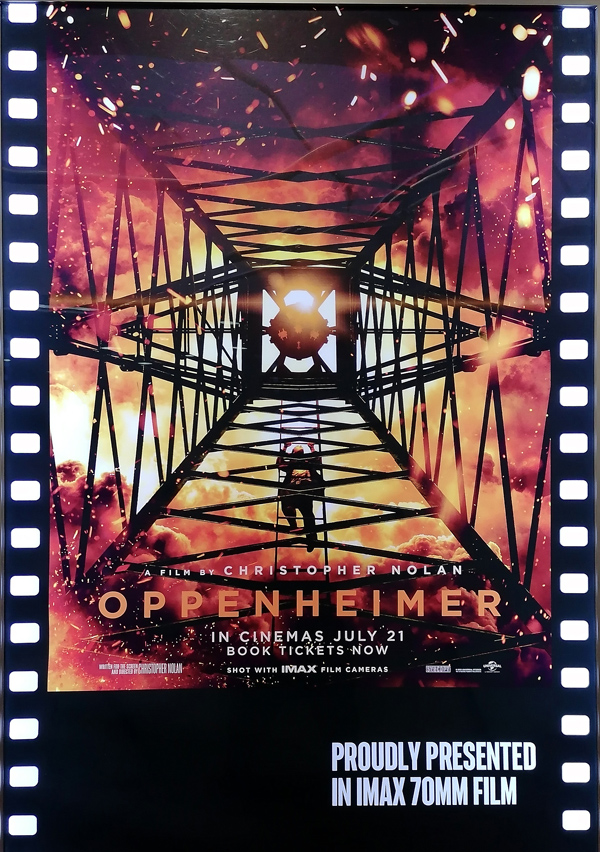 A
person strives for something, does something, there are consequences, and
the person reflects on, and may come to regret or be haunted by what they
have done. This simple story is one of the oldest and essential narratives
of drama – from ancient times up until today. Christopher Nolan by exploring
the story of Robert Oppenheimer, who led the scientific team that developed
the atomic bomb - the power to obliterate cities, incinerate populations and
destroy life on this planet, and his subsequent reflections on what he
brought about – raises such a simple story to truly epic proportions. This
accompanied by some political and societal vilification of the man, adds
even more to this epic drama. A
person strives for something, does something, there are consequences, and
the person reflects on, and may come to regret or be haunted by what they
have done. This simple story is one of the oldest and essential narratives
of drama – from ancient times up until today. Christopher Nolan by exploring
the story of Robert Oppenheimer, who led the scientific team that developed
the atomic bomb - the power to obliterate cities, incinerate populations and
destroy life on this planet, and his subsequent reflections on what he
brought about – raises such a simple story to truly epic proportions. This
accompanied by some political and societal vilification of the man, adds
even more to this epic drama. Following 2-3 weeks of completely sold out screenings of the film at this iconic venue, my wife and I, and two friends, caught up with the film at another sold out screening on August 8th. Michael Ford, the technical manager, told me after the screening that their print had been screened some 70 plus times prior to our screening. It looked absolutely immaculate on the screen in our show. A tribute to this fabulous analogue IMAX format and the projection team at the venue. The depth, detail and richness of the celluloid analogue images on the screen were a joy to behold. • Go to 65mm Film: The Fabric of Magic. Part 1 – The Kodak View • Go to Projecting “Napoleon” – une pièce de resistance Both the power and irony of "Oppenheimer" as a movie, and its bringing about the coming of age of IMAX as a cinematic artistic tool, is that it totally succeeds on playing against type, on what both 70mm and widescreen enthusiasts, and a more general audience, might expect of a true IMAX film. IMAX has now come a long long way from how it started – a format that was growing a catalogue of short 30, 40, 50 minute short featurettes of travel, exploration, underwater, wildlife, and outer space type subjects. It has developed technically, narratively, and creatively, and is living a much longer life, in the way that three strip true Cinerama was never able to do. Many of Nolan’s great preceding films like "Tenet", "Dunkirk", “Interstellar”, "The Dark Knight" – played on IMAX’s brilliance in using the huge cinematic canvas to portray and explore spectacular action, large numbers of extras, sweeping landscapes, seascapes, cityscapes and skyscapes and fantastic production design and special and visual effects. The brilliance of “Oppenheimer” in bringing about the maturity of IMAX as a cinematic tool is how it portrays a truly epic theme in such a very intimate way. It draws the audience into the story via extremes acts of visual intimacy. Just Oppenheimer’s face in extreme close up is repeatedly used on the huge canvas of the IMAX screen. It is also repeatedly emphasised by the use of a shallow depth of field. Cillian Murphy’s face fills the giant screen and the audience is confronted by a person haunted by the consequences of what he has done. This being in IMAX it is done in the most intimate cinematic way possible. This intimacy is emphasised by the sheer quality of the IMAX 15perf 70mm format – you can almost count every pore on the skin of his face. The effect to me was not that far removed from the suffering, and all the weight of all the sins of mankind, being reflected on Christ’s face in Christian religious iconography. Whilst obviously the film has a good explosion or two , and in that fact some instances of spectacular action, and effects – the intimacy that IMAX is capable of, to me, was a revelation. This is a film that consists more of ideas, scientific thought, arguments, words, people working and speaking in sometimes small rooms, relationships, moral dilemma and politics rather than the sweeping landscapes, spectacular action and epic production design normally associated with the IMAX format. To me, in successfully achieving this epic piece of storytelling, involving sometimes difficult content, to a general audience, in such a very intimate way, Nolan has further developed IMAX significantly. On a minor note, like many a current “tentpole” movie being released today, I personally thought it could have benefited from being a little bit shorter and tighter in length – but perhaps that is just me. I thought exactly the same of the latest “Mission Impossible” movie that we saw the next day. |
|
 Audience
Arriving for "Oppenheimer" at BFI IMAX. Picture: Mark Trompeteler Audience
Arriving for "Oppenheimer" at BFI IMAX. Picture: Mark Trompeteler“Oppenheimer” is a film of cinematic sophistication. Taking on the classic Jean Luc Godard concept of - “Every film should have a beginning, a middle and an end, but not necessarily in that order” – “Oppenheimer” inter-cuts between different time periods. The colour parts of the film seem concerned with the telling of his story from a personal, chronological, almost autobiographical point of view relating to testimony he is giving in a small room as part of his security clearance hearing. This is inter-cut with an almost public societal point of view of public testimonies and senate hearings filmed in a black and white documentary way. Nolan’s acceleration of developing IMAX to mature sophisticated cinematic medium, that has now fully come of age, lies not only in his direction, but in his conception and writing of the highly literate screenplay for this film too. The whole experience of "Oppenheimer" is also propelled by Nolan’s use of music. Almost as an ever increasingly rapid metronome the characteristic prominent use of loud music layered over and throughout the film facilitates the sense of suspense and significantly manipulates the emotional impact and the pace of the film. The use of fast short cuts and abstract imagery to hint at Oppenheimer’s thought processes and the immensity of what he is dealing with goes right back to the cinematic techniques of Gance and Eisenstein. With superb large format cinematography, excellent period production design and some great performances – it is all woven together to make this an outstanding film. No single Director has done more to develop true IMAX to the powerful medium that it has now become. Thanks to Nolan’s “Oppenheimer” – true IMAX has truly come of age ! Mark Trumpeteler London, UK |
|
"Oppenheimer" in 15/70 IMAX
|
|
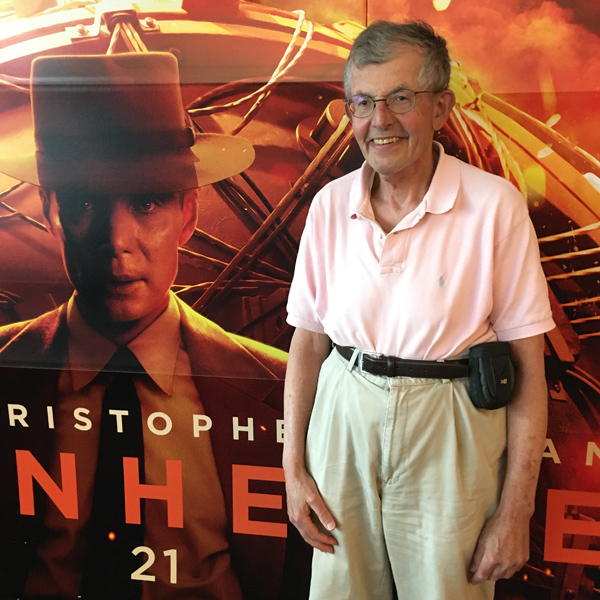 Author Jonathan
Kleefield, M.D. having just attended an IMAX 70mm performance of
"Oppenheimer", 8. August 2023. Author Jonathan
Kleefield, M.D. having just attended an IMAX 70mm performance of
"Oppenheimer", 8. August 2023.In a past contribution to this journal (“Eighteen Years Later”), I recounted my difficulties in viewing Steven Spielberg’s “West Side Story” in an IMAX-branded theatre. Issues with image clarity and contrast, and deafening sound levels made the experience very unpleasant. The remedy was to view the same film in my home theatre, using a 4K UHD disc. Some improvement in the viewing experience was also achieved when I viewed Christopher Nolan’s "Dunkirk" in the same home theatre, again with a 4K UHD disc. • Go to A Nostalgic View of 70mm in New York City - 1950-1970 • Go to Eighteen Years Later • Go to Now showing in 70mm in a theatre near you! Nevertheless, for nearly a year there has been a virtual media blitz about Nolan’s current film, "Oppenheimer", particularly as it is the first large scale dramatic film to be acquired with IMAX 15/70 technology, though for dialog scenes, 65mm Panavision equipment was substituted as the current IMAX film cameras are too noisy to permit live dialog recording. Also, Nolan commissioned Eastman Kodak to produce a black and white IMAX film stock, which was to be used for selected portions of the film involving the presidential cabinet nomination of Oppenheimer’s nemesis, Lewis Strauss. A significant feature of this film is that it was to be shown in IMAX 15/70 in only 30 theaters worldwide, 19 of which were in the USA. In one of those theaters, in Providence, Rhode Island, I attended the showing yesterday morning. The theatre itself seats about 400 people, and has about 13 rows, in a stadium configuration, allowing an excellent line of sight. My seat was in row J near the center, considered nearly ideal. There were no advertisements before the film started - a true relief. The screen itself was very large, and while there were segments that were filmed in 65mm, having a wider aspect ratio than the nearly square IMAX format, the change in formats was not overtly distracting. The image itself was quite clear, but sadly, scenes that were dimly lit, with large areas that were dark in the frame were not rendered inky black, but rather a weak black cast reminiscent of LCD flat screens of twenty years ago. That is, in those areas, you could perceive the actual screen material, rather than the image itself. People who have been writing about home video have been emphasizing for years how important having those “inky black” parts of the image literally allow it to “pop.” This deficiency was not as apparent in brightly lit scenes. Scenes showing this rather weak contrast included the sunrise horseback ride in Los Alamos, and a chat by a fireside, again in Los Alamos. I know the Kodak Vision 3 film stock used for this film, as indicated in the Kodak brochure, has a formulation of “dye layering” that tries to maximize image contrast, so I suspect that this viewing impression is a limitation of the projection system. I can’t imagine a “colorist” would have deliberately altered the image in post-production to create this effect, although their work was more than apparent in the outdoor scenes filmed at the University of California Berkeley campus. A color palette overemphasizing the green grass, but attenuating the blue sky and yellow values was employed, appearing quite different from the scenes in Los Alamos, which had a far warmer color spectrum. I know colorists try to create the mood of a specific era by altering the color - a technique which I often find artificial and distracting, rather than supportive of the drama. |
|
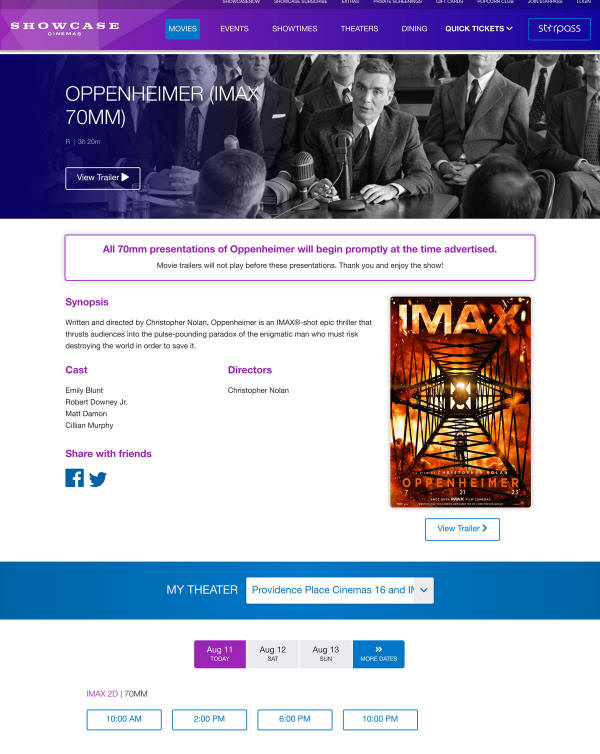 The
projector itself produced a rock steady image, and it was rather remarkable
that after passing that film through it nearly 80 times since the premiere,
that there was no sign of scratching, or obvious dust. Credit must go to
both Kodak for making such a sturdy film stock, as well as the care used by
the projectionist(s) in handling this 11 mile long reel of film! There was negligible visible film grain in either the color or black and white sequences. The
projector itself produced a rock steady image, and it was rather remarkable
that after passing that film through it nearly 80 times since the premiere,
that there was no sign of scratching, or obvious dust. Credit must go to
both Kodak for making such a sturdy film stock, as well as the care used by
the projectionist(s) in handling this 11 mile long reel of film! There was negligible visible film grain in either the color or black and white sequences. A more serious problem arose with the sound. As I had experienced in my previous theater visit, the overall sound level was extremely loud, and Nolan’s tendency to obscure dialog with ever escalating levels of music and/or sound effects made it difficult to hear some key phrases. The overall deafening sound throughout the film resulted in the explosion at Trinity being almost anti-climactic. My ears were “ready” for a big bang by that time, having been assaulted for nearly two hours prior to it occurring! Also, it’s my opinion that despite Nolan’s zeal for “practical effects,” including that used for the Trinity test, it would have been more effective to use the actual bomb footage as a basis for creating a more believable explosion. I know the real explosion was originally filmed in black and white, but since Nolan already used black and white film for segments of his production, the shift should not have been jarring. The high speed photography available for viewing that explosion, in my opinion, is about as horrifying as you can get and shows fascinating elements of the fireball’s architecture not reproduced in Nolan’s recreation. If you don’t believe me, it’s all on You Tube! I will be planning to buy the 4K disc of this film and see if the issues I raised above can be corrected - I am confident most will no longer be a problem. Additionally, I should mentioned that I had already read the biography of Oppenheimer used as the basis of Nolan’s script, and thus I was better prepared to watch this film. Having been involved with physics all my life, and having also read the excellent Richard Rhodes books about the atomic and hydrogen bomb, that knowledge helped me to understand what was going on during this film. However, particularly given Nolan’s tendency to jump back and forth in his narrative, without explaining things to his audience, I can imagine many people did not truly understand the events being shown to them other than in a most superficial fashion. I feel a subject as important as this one deserves a film where an audience member can learn a bit more about the issues raised by viewing it. The jumbling of events in this film made that aspect of this movie hard to assimilate. However, I feel Nolan is to be commended for taking it on, and his cinematic flare is most beautifully illustrated in a scene not talked about in most reviews. Immediately after Hiroshima, Oppenheimer is to go into a lecture hall at Los Alamos to join in the celebration. To the shouts of “Oppy!, Oppy!”, he walks into the room, only to have the sound of the cheers shut off, followed by the ominous nuclear flash, and then images suggesting immolation of his staff. This sequence was a superb synthesis of cinematic devices that surely would have made Sergei Eisenstein, the great Russian director, tip his hat (not a pork pie type) towards Mr. Nolan. In whatever setting you see this film, it is more than worth your time. Jonathan Kleefield, Boston, USA 10.08.2023 |
|
The movie itself was good
|
|
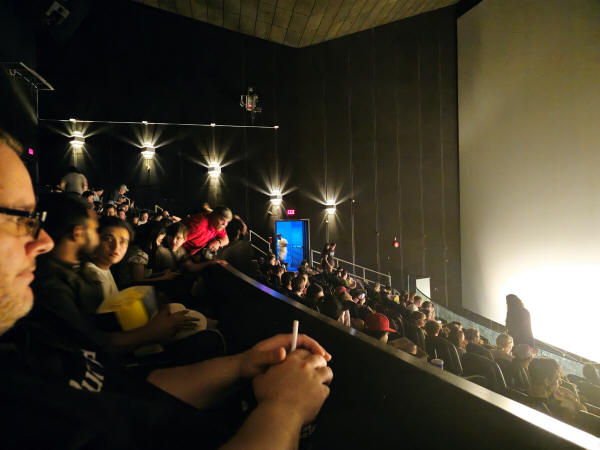 Langley
IMAX in BC Canada. Picture by: Scott Pickering Langley
IMAX in BC Canada. Picture by: Scott PickeringBeing a big fan of true IMAX using 70mm film prints, I had to see this release in 70mm when it came available in my area once again. I saw "Dunkirk" in this same theater in 70mm IMAX 6 years ago. This was one of the few theaters left that still kept their 70mm projection system. I have been watching real IMAX since 1986, when it first became available in Vancouver BC at Expo 86. That theater has since shut down the IMAX films, so Langley was the only one left. Im not sure if the OMNIMAX at the Science World still offers film projection. The Langley theater has had its IMAX venue since the late 90s I believe. I saw quite a few true IMAX films in this theater over time, with quite a few of them being Nolan films. Why is Nolan the ONLY director that will still insist on 70mm prints for his films? I wish more of them would. I was also happy to see this release with the B&W portions shot on real B&W film, as I too myself wished I could make a film that way at one time. Nolan is the guy who could get that done though. Now on to this new release. I got my tickets a month in advance and it slowly sold out each showing the closer it go to release. I got my ticket the first day it was available. My ticket was for the 2PM show on Saturday the 22nd. Once I knew Langley was once again showing a 70mm print, I was waiting to get my ticket. The day we got there, the theater was of course sold out. People were wandering all over trying to find their seats. The ushers came in to help. There were people from all over in our viewing. I sat next to a couple guys who came all the way up from Seattle to see this here. They no longer have 70mm options in their city to see it this way. I heard some other people flew in just to see this show. Before it started, one of the theater staff introduced the show and talked a little bit about this presentation. I missed out on getting the handout film print clip of IMAX. They ran out. So the movie began and it was how I remembered film prints being. |
|
 This print did weave a little at times, you could clearly see the flicker on
the screen, and the image was not quite rock steady. There was dust on the
print a couple times too. So this was obviously a film print I was watching.
You get so used to the clean stable digital presentations, that seeing film
once again is a little unusual. I loved what I was looking at. Being one of
the 31 theaters showing in IMAX, I felt privileged and very lucky. The
presentation didn’t have any mechanical issues like some other venues in
Canada have had this last week. I hope they get their problems sorted out. This print did weave a little at times, you could clearly see the flicker on
the screen, and the image was not quite rock steady. There was dust on the
print a couple times too. So this was obviously a film print I was watching.
You get so used to the clean stable digital presentations, that seeing film
once again is a little unusual. I loved what I was looking at. Being one of
the 31 theaters showing in IMAX, I felt privileged and very lucky. The
presentation didn’t have any mechanical issues like some other venues in
Canada have had this last week. I hope they get their problems sorted out.The 70mm 5 perf sections on the print looked very good. Better that Dunkirk did on its print. I could still see a bit of a contrast difference between the IMAX and 5 perf sections though. The 5 perf stuff held up very well on the IMAX print. The B&W portions showed the grain, even in 70mm. The B&W IMAX sections were noticeably less grainy, and that surprised me, since 5 perf isn’t that much of a blow up if at all. I didn’t really see much of a tint in the B&W segments, as some others have reported showing green tints. I still think it would have looked better if a B&W print was an option. Duping B&W to color print stock never looks as good. But it was a real treat to see B&W in 70mm. I wish this would be an option again for future film makers. Fotokem said they would consider doing it again if the right amount of stock was sent to them. But their lab manager says no to that. The color segments of the film looked softer than I remembered IMAX being. A softer look is a film trait, even in 70mm. I certainly don’t see how IMAX can be 18K rez, after view IMAX film again today. I think 8K would give it a run for its money. But needless to say I'm a tried and true film nut. I love using film myself for photography. I really have to admire for Nolan sticking to his guns using film for his movies. He and I would make many of the same decisions if I was making films myself. Old school just looks better. The movie itself was good. I need another viewing just to try and make sense of some of it. I wouldn’t say this was Nolan’s best work, as its different to me than some of his other movies. But I have to admire what he was able to achieve. I hope there are more opportunities to see 70mm IMAX here in BC. But I'm concerned at some point they may give it up, especially if Nolan stops making films. Scott Pickering, BC, Canada 24.07.2023 |
|
"Oppenheimer" is the film of the
year
|
|
 Mark
Lyndon with a Geiger Müller counter
*)
at the BFI IMAX London, UK. Picture by: Tim Collins Mark
Lyndon with a Geiger Müller counter
*)
at the BFI IMAX London, UK. Picture by: Tim Collins"Oppenheimer" is the film of the year, selling out to packed houses, mesmerizing and capturing the complete and rapt attention of of the BFI IMAX audience. "Oppenheimer" is a phenomenal masterpiece, a white hot contender for the greatest large format film of them all. "Oppenheimer" is an artistic triumph in every department. Here, Nolan has surpassed even himself. Here is some of the most compelling drama ever presented in any medium. Cillian Murphy gives a shattering, career defining performance as Oppenheimer with superb performances from a starry supporting cast, including Emily Blunt as his deeply troubled wife Kitty, Matt Damon as the tough, no nonsense overseer of the Project, General Groves. Robert Downey Jr. as Oppenheimer’s friend and nemesis, Lewis Strauss. The plum rôle of Niels Bohr, the great Danish Physicist, who dubbed Oppenheimer as the American Prometheus, after the tragic hero of Greek mythology who gave fire to mankind and was duly punished eternally for his pains; is given here to the great Kenneth Brannagh. How right Bohr was. The cinematography of Hoyte van Hoytema ranks amongst the most sublime ever to grace a giant screen. Hoyte is an accomplished master of the craft of colour as well as black and white cinematography, a great artist. Thanks to Nolan, the world has come to learn, once more, just how great large format cinema can be. IMAX 70mm film is now the pinnacle of the art of the moving image. Mark Lyndon, in70mm.com, London, UK 22.07.2023 |
*) If it reads over 50 CPM start worrying. If it reads over 100 CPM, run like hell. |
| Go: back - top - back issues - news index Updated 22-01-25 |
